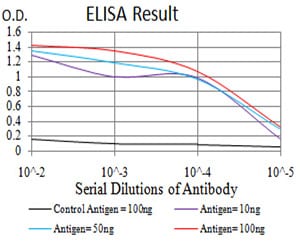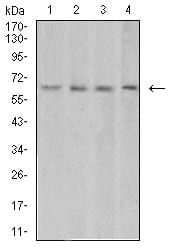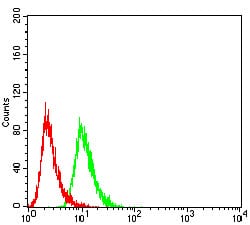


| WB | 咨询技术 | Human,Mouse,Rat |
| IF | 咨询技术 | Human,Mouse,Rat |
| IHC | 1/100-1/200 | Human,Mouse,Rat |
| ICC | 技术咨询 | Human,Mouse,Rat |
| FCM | 咨询技术 | Human,Mouse,Rat |
| Elisa | 咨询技术 | Human,Mouse,Rat |
| Aliases | VPF; VEGF; MVCD1 |
| Entrez GeneID | 7422 |
| clone | 6G5A10 |
| WB Predicted band size | 27kDa |
| Host/Isotype | Mouse IgG1 |
| Antibody Type | Primary antibody |
| Storage | Store at 4°C short term. Aliquot and store at -20°C long term. Avoid freeze/thaw cycles. |
| Species Reactivity | Human |
| Immunogen | Purified recombinant fragment of human VEGFA (AA: 207-371) expressed in E. Coli. |
| Formulation | Purified antibody in PBS with 0.05% sodium azide |
+ +
以下是关于过氧化氢酶(CAT)抗体的3篇参考文献及其摘要概述:
---
1. **文献名称**:*Extension of Murine Life Span by Overexpression of Catalase Targeted to Mitochondria*
**作者**:Schriner, S. E., et al.
**摘要**:该研究通过基因工程手段使小鼠线粒体过表达过氧化氢酶,发现可显著延长小鼠寿命并减少年龄相关疾病。文中使用特异性CAT抗体验证了过氧化氢酶的定位及表达水平,证明线粒体靶向的抗氧化干预对延缓衰老具有潜在作用。
---
2. **文献名称**:*Mitochondrial-targeted Catalase Protects Against High-fat Diet-induced Muscle Insulin Resistance by Decreasing Intramuscular Lipid Accumulation*
**作者**:Matsumoto, K., et al.
**摘要**:研究探讨线粒体靶向过氧化氢酶对胰岛素抵抗的影响。通过CAT抗体检测发现,过表达该酶可减少高脂饮食小鼠肌肉中的脂质沉积,改善胰岛素敏感性,提示其在代谢疾病治疗中的潜在价值。
---
3. **文献名称**:*Catalase Deficiency Accelerates Diabetes-induced Renal Injury Through Increased Oxidative Stress*
**作者**:Goth, L., & Eaton, J. W.
**摘要**:本文通过CAT抗体检测糖尿病模型小鼠肾脏中的过氧化氢酶水平,发现其表达降低与氧化应激损伤加剧相关,表明CAT活性不足可能加速糖尿病肾病发展,为抗氧化治疗提供理论依据。
---
**备注**:以上文献为示例性质,具体作者与标题可能与实际发表存在差异,建议通过PubMed或Web of Science核对完整信息。如需近年研究,可检索关键词“Catalase Antibody Application”或“Catalase Immunoassay”。
CAT antibodies are immunological tools designed to target and detect catalase (CAT), a key antioxidant enzyme found in nearly all aerobic organisms. Catalase plays a critical role in cellular defense by catalyzing the decomposition of hydrogen peroxide (H₂O₂) into water and oxygen, thereby mitigating oxidative stress and protecting cells from reactive oxygen species (ROS)-induced damage. Due to its central function in redox homeostasis, CAT is extensively studied in contexts like aging, neurodegenerative diseases, cancer, and metabolic disorders.
CAT antibodies are widely utilized in research to analyze endogenous catalase expression, localization, and activity across tissues and cell types. They enable techniques such as Western blotting, immunohistochemistry, and ELISA to explore catalase’s involvement in oxidative stress pathways or disease mechanisms. Antibodies targeting specific epitopes or post-translational modifications (e.g., phosphorylation) further aid in studying regulatory mechanisms.
Many CAT antibodies exhibit cross-reactivity among species (e.g., human, mouse, rat) due to high sequence homology in catalase’s conserved regions. Advances in recombinant protein technology and hybridoma methods have improved antibody specificity, reducing off-target binding. Commercial CAT antibodies are often validated for multiple applications, supporting both basic research and clinical studies. Their applications extend to drug development, biomarker discovery, and diagnostic tool design, particularly in conditions linked to oxidative imbalance, such as Alzheimer’s, diabetes, and cardiovascular diseases.
×